On the Fence of Whether or Not To Move This Spring? Consider This.

If you’re thinking of selling your house, it may be because you’ve heard prices are rising, listings are going fast, and sellers are getting multiple offers on their homes. But why are conditions so good for sellers today? And what can you expect when you move? To help answer both of those questions, let’s turn to the data.
Today, there are far more buyers looking for homes than sellers listing their houses. Here are the maps of the latest buyer and seller traffic from the National Association of Realtors (NAR) to help paint the picture of what this looks like:
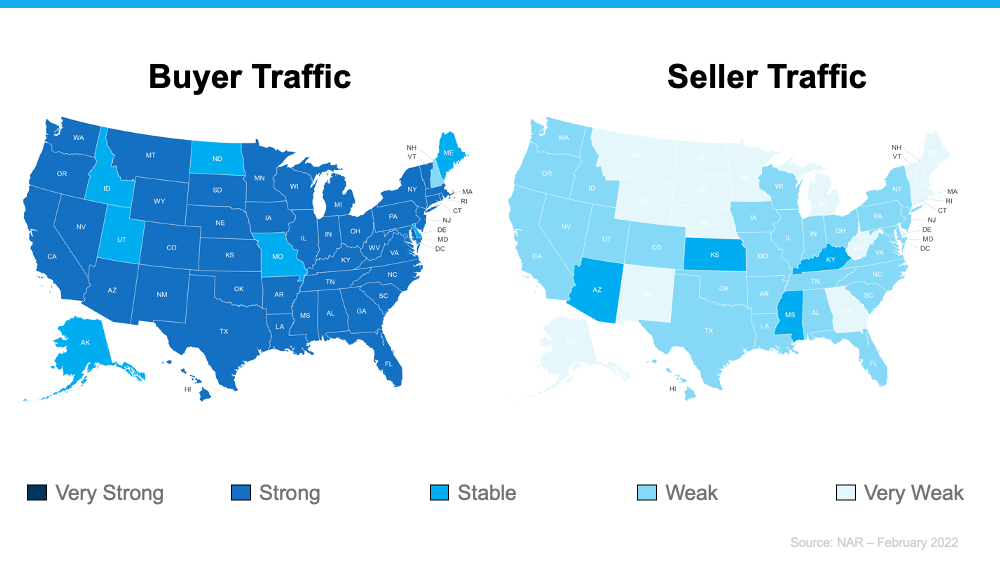
Notice how much darker the blues are on the left. This shows buyer traffic is strong today. In contrast, the much lighter blues on the right indicate weak or very weak seller traffic. In a nutshell, the demand for homes is significantly greater than what’s available to purchase.
What That Means for You
You have an incredible advantage when you sell your house under these conditions. Since buyer demand is so high at a time when seller traffic is so low, there’s a good chance buyers will be competing for your house.
According to NAR, in February, the average home sold got 4.8 offers. When buyers have to compete with one another like this, they’ll do everything they can to make their offer stand out. This could play to your favor and mean you’ll see things like waived contingencies, offers over asking price, earnest money deposits, and more. Selling when demand is high and supply is low sets you up for a big win.
If you’re also looking to buy a house, you may be tempted to focus more on just the seller traffic map and wonder if it means you’ll have trouble finding your next home. But remember this: perspective is key. As Danielle Hale, Chief Economist at realtor.com, says:
“The limited number of homes for sale is a lesson in perspective. This same stat that frustrates would-be homebuyers also means that today’s home sellers enjoy more limited competition than last year’s home sellers.”
If you look at the big picture, the opportunity you have as a seller today is unprecedented. Last year was a hot sellers’ market. This year, inventory is even lower, and that means an even bigger opportunity for you. Even though finding your next home in a market with low inventory can be challenging, is that concern worth passing on some of the best conditions sellers have ever seen?
As added peace of mind, remember real estate professionals have been juggling this imbalance of supply and demand for nearly two years, and they know how to help both buyers and sellers find success when they move. A skilled agent can help you capitalize on the great opportunity you have as a seller today and guide you through the buying process until you find the perfect place to call your next home.
Bottom Line
If you’re ready to move, you have an incredible opportunity in front of you today. Trust the experts. Let’s connect so you have expertise on your side that can help you win when you sell and when you buy.
Courtesy of Keeping Current Matters
Idaho 2019 3rd Quarter Real Estate Economic Report

 |
The following analysis of select counties of the Idaho real estate market is provided by Windermere Real Estate Chief Economist Matthew Gardner. We hope that this information may assist you with making better-informed real estate decisions. For further information about the housing market in your area, please don’t hesitate to contact us.
ECONOMIC OVERVIEW In August, the state unemployment rate was 2.9%, marginally higher than the 2.8% rate a year ago. It cannot be disputed that the state remains at full employment. It’s also interesting to note that the employment rate remained below 3% even as the labor force rose by 2.2%, suggesting that the economy remains very strong and new entrants to the labor force are finding jobs relatively easily. |
|
|
| HOME SALES | ANNUAL CHANGE IN HOME SALES Q3-2018 TO Q3-2019 |
| ❱ During the third quarter, 7,342 homes sold, representing a modest drop of 3.4% compared to the third quarter of 2018.
❱ In Northern Idaho, Shoshone County experienced a 17.9% increase in sales over the third quarter of 2018. There was a modest increase in Bonner County and a very slight contraction in Kootenai County. In Southern Idaho, sales jumped in Boise and Canyon counties. Blaine County also saw a slight increase, but sales activity was lower in the rest ❱ Year-over-year sales growth was positive in two Northern Idaho counties and three Southern Idaho counties. ❱ Pending sales rose in the third quarter, suggesting that closed sales in the final quarter of this year are likely to be an improvement over current figures. |
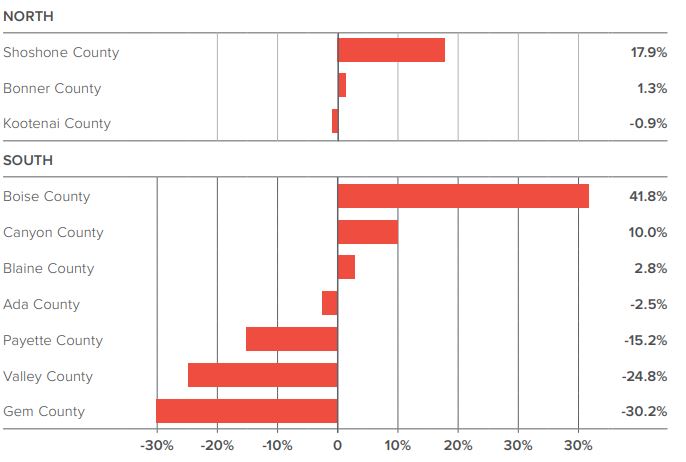 |
HOME PRICES
| ❱ The average home price in the region rose 8% year-over-year to $367,963. Prices were 2.7% higher than in the second quarter of this year. ❱ Prices rose in all counties compared to the third quarter of 2018. |
❱ In Northern Idaho, Shoshone County led the market with the strongest annual price growth. Bonner County also had solid price growth. In Southern Idaho, Gem County saw prices rise a very significant 29.7%, and there were notable increases in Valley, Canyon, and Boise counties. | ❱ Inventory continues to be an issue. The number of homes for sale is down 3.4% compared to the third quarter of 2018. Although listings are up 7% over the second quarter, the market remains very tight, and this is pushing prices higher. |
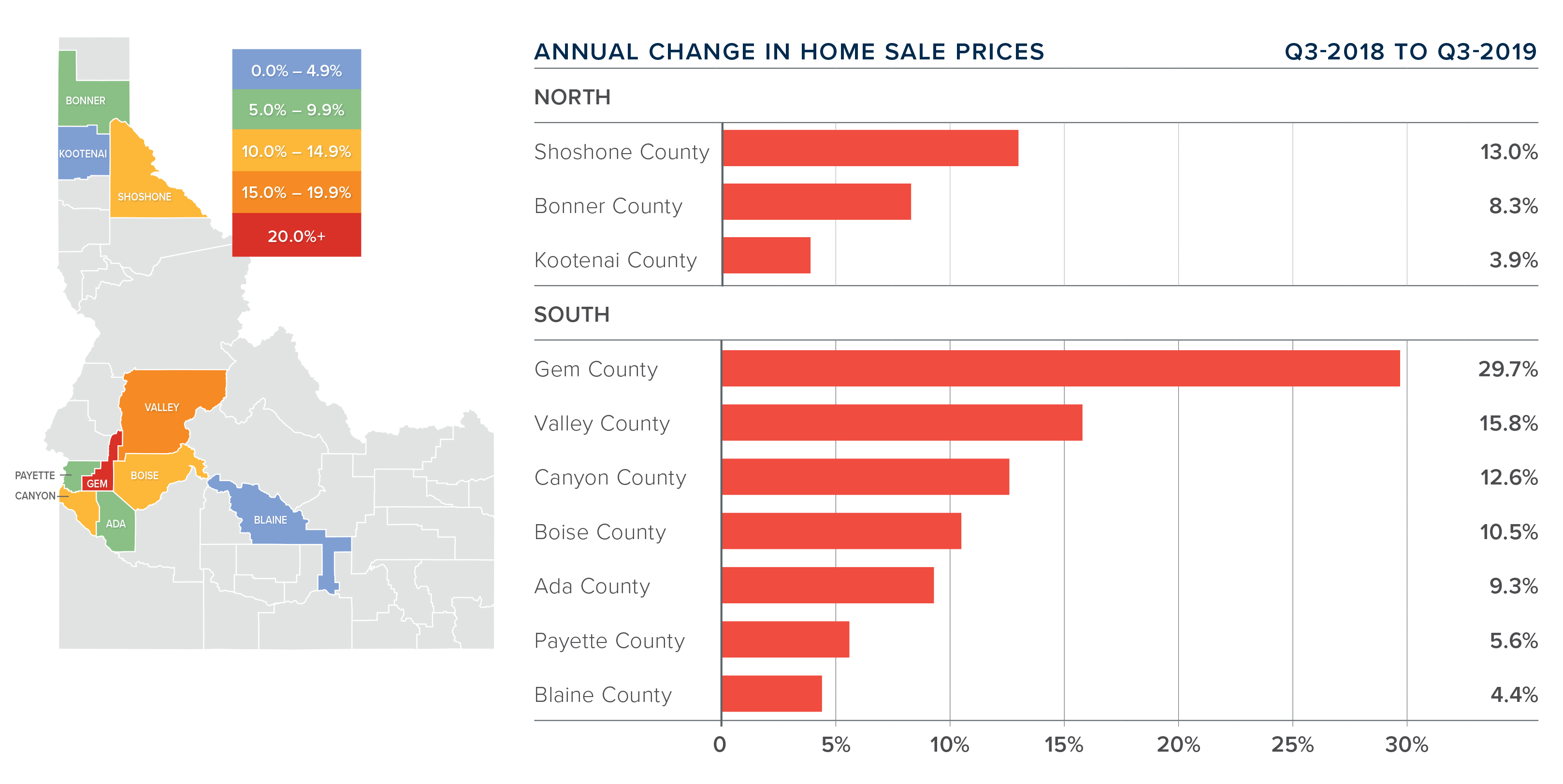
| ❱ It took an average of 94 days to sell a home in Northern Idaho, and 54 days in the southern part of the state.
❱ The average number of days it took to sell a home in the region dropped ten days compared to the third quarter of 2018. It was also ten days lower than in the second quarter of this year. |
❱ In Northern Idaho, days-on-market dropped across the board. In Southern Idaho, market time dropped in all counties except Ada and Canyon, though the rise in average market time was very modest.
❱ Homes sold the fastest in Gem, Canyon, and Ada counties. |
 |
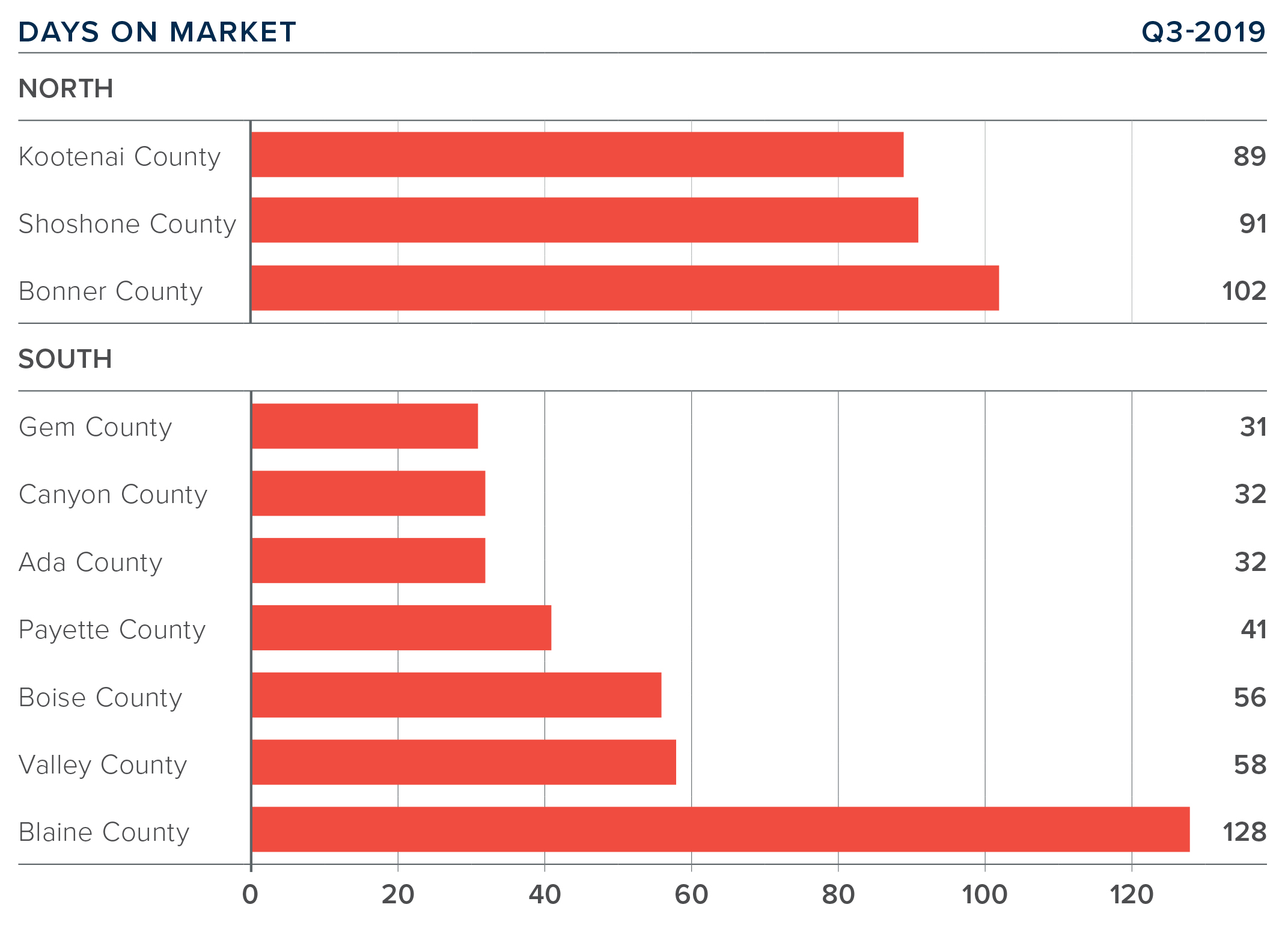 |
The speedometer reflects the state of the region’s housing market using housing inventory, price gains, home sales, interest rates, and larger economic factors.
Job growth continues to slow from the frenetic pace of the past few years but remains quite impressive. As is commonly known, economic/job growth leads to demand for homeownership and this continues to bode well for the Idaho market; however, home sales continue to be held back by a lack of inventory and this is leading to higher prices. As such, it remains a sellers’ market so I have moved the needle just a little more in their direction. ABOUT MATTHEW GARDNER Governors Council of Economic Advisors; chairs the Board of Trustees at the WA Center for Real Estate Research; and is an Advisory Board Member at the Runstad Center for Real Estate Studies at the University of Washington where he also lectures in real estate economics. |
|
Economic Update for Idaho Real Estate Market

The following analysis of select counties of the Idaho real estate market is provided by Windermere Real Estate Chief Economist Matthew Gardner. We hope that this information may assist you with making better-informed real estate decisions. For further information about the housing market in your area, please don’t hesitate to contact your Windermere agent.
ECONOMIC OVERVIEW
Job growth in Idaho continues to moderate. The state added 19,400 new jobs over the past 12 months, representing an annual growth rate of 2.7%. That said, the growth rate remains well above the national average of 1.7%. In March, Idaho’s unemployment rate was 2.9%, matching the level seen a year ago. The state remains at full employment, and it’s worth noting that the employment rate remained below 3% even as the labor force rose by 2%. This suggests the economy remains very strong as there are still job openings to accommodate new workers. Idaho continues to outperform the nation in terms of economic vitality and will continue to do so for the balance of the year.
HOME SALES
- 4,440 homes were sold during the first quarter of 2019, representing a drop of 4.3% compared to the first quarter of 2018.
- In Northern Idaho, Shoshone County was alone in experiencing sales growth, with an increase of 12% over the first quarter of 2018. There was a substantial drop of more than 15% in Bonner County, but this is a small area, making it prone to significant swings. In Southern Idaho, we saw modest sales growth in Payette County, modest declines in Canyon and Ada counties, and significantly lower sales in the small area of Boise County.
- Year-over-year sales growth was positive in just one Northern Idaho market, and only one of the Southern Idaho markets saw sales rise relative to the same period a year ago.
- When compared to the first quarter of 2018, the number of homes for sale was lower across the board in Northern Idaho and in most Southern Idaho market areas. It’s likely that this contributed to the decline in sales.
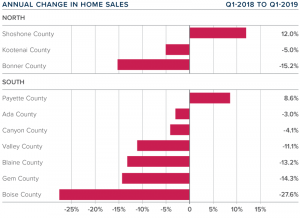
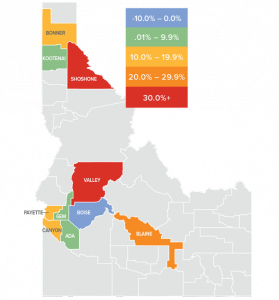
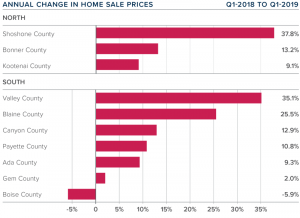
The Idaho Economic Report by Matthew Gardner


The following analysis of select counties of the Idaho real estate market is provided by Windermere Real Estate Chief Economist Matthew Gardner. We hope that this information may assist you with making better-informed real estate decisions. For further information about the housing market in your area, please don’t hesitate to contact our office.
ECONOMIC OVERVIEW
Job growth in Idaho slowed in the fall of 2018 but the state added 13,200 new jobs over the past 12 months, representing an annual growth rate of 1.8%.
In November, the state unemployment rate was 2.6%, down from 3% a year ago. The state remains at full employment, which explains why we are seeing a slowdown in employment growth. I fully anticipate that the state will return to above-average growth in 2019 and continue its trend of adding jobs at well above the national pace.
HOME SALES ACTIVITY
- 5,308 homes were sold during the fourth quarter of 2018, representing a drop of 3% compared to the final quarter of 2017. Continue reading…

 Facebook
Facebook
 Twitter
Twitter
 Pinterest
Pinterest
 Copy Link
Copy Link